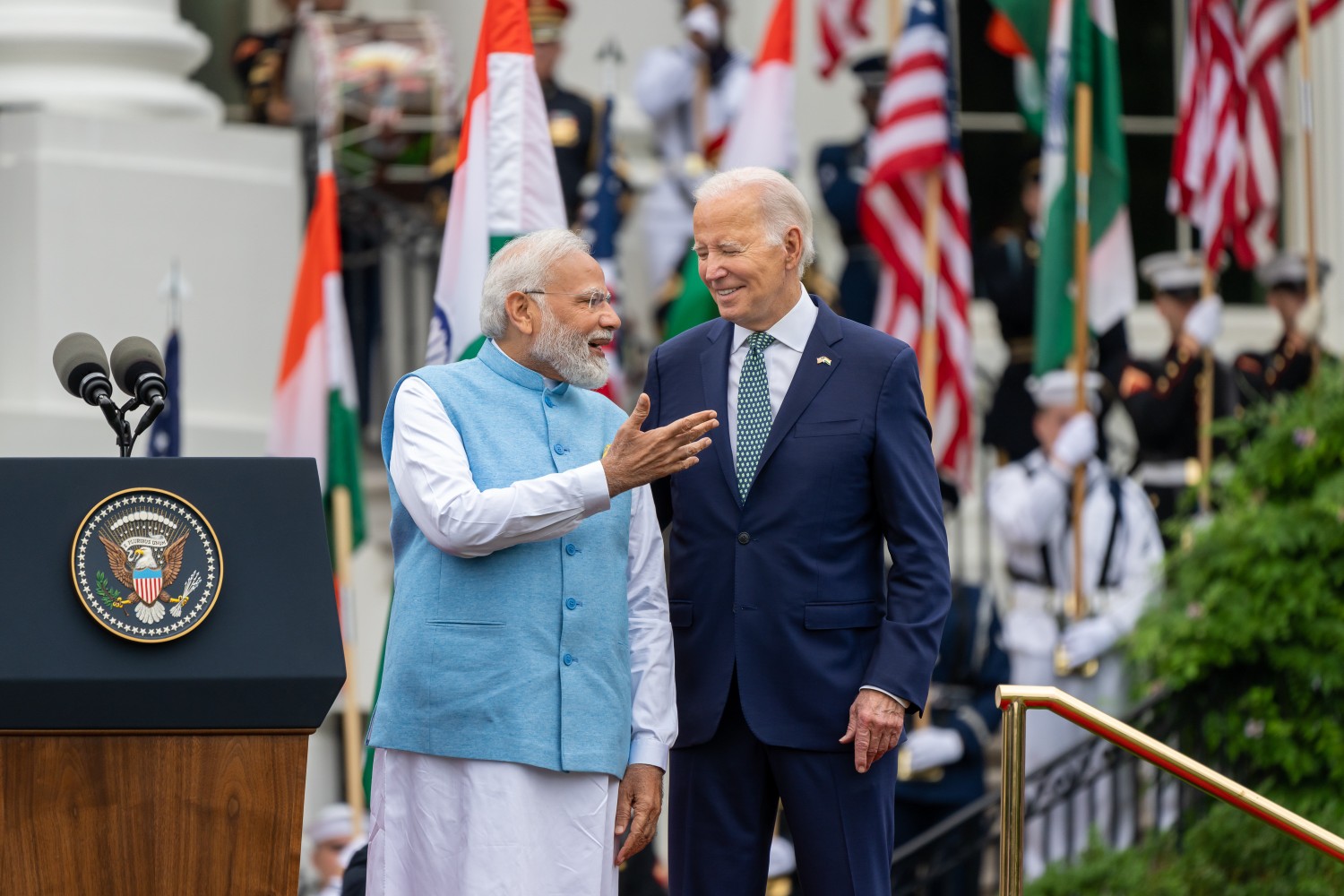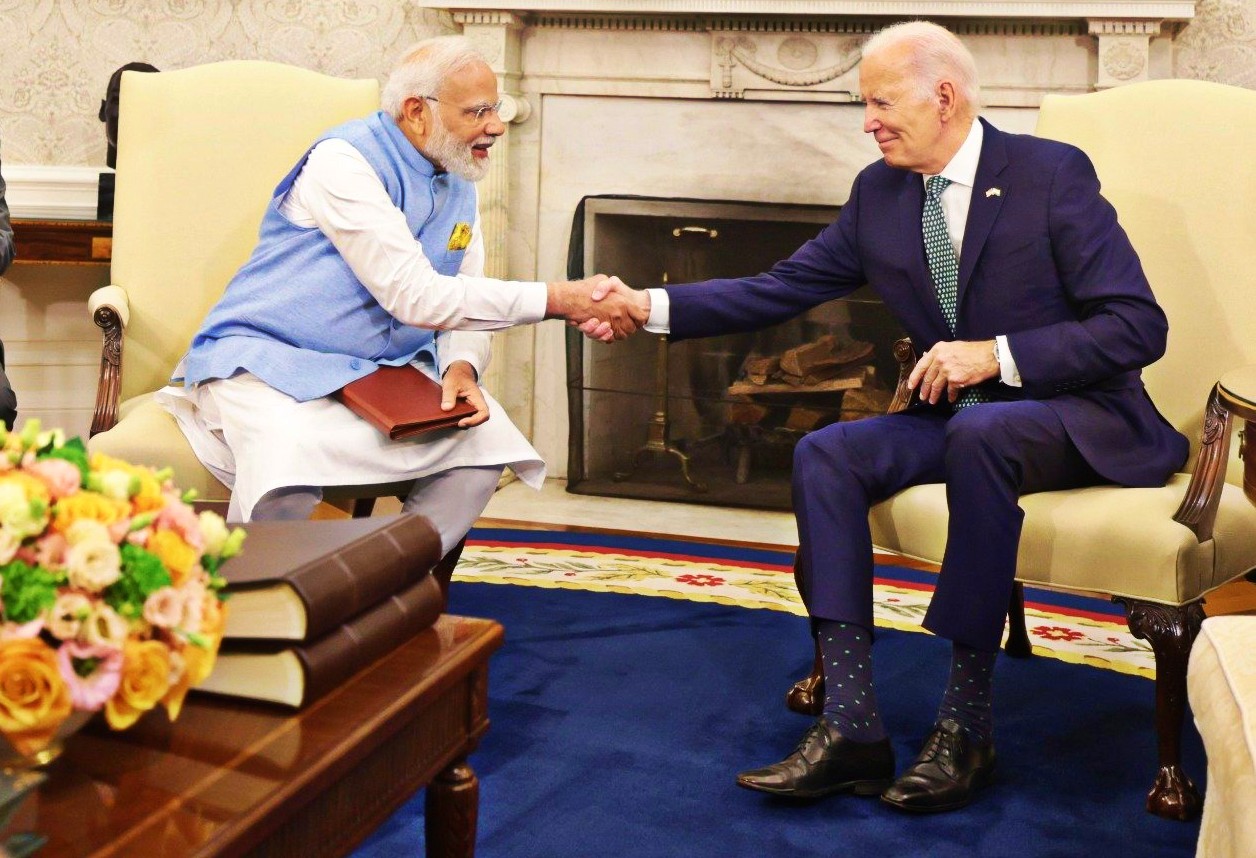Is the much-hyped relationship between India and the United States increasingly becoming fragile? Are the “estranged democracies” during the Cold War finding it difficult to keep their “growing engagements” in momentum?
Answers to these questions are likely to come under deeper scrutiny when both countries are in election mode. Headlines on recent developments in their bilateral relations have been marked by more discord than harmony.
The Biden Administration terms America’s relationship with India as one of its most “consequential relationships.” And yet, its bureaucrats, diplomats, a select group of the ruling party legislators (Democrats), and, above all, the media have been really nasty and hostile to India in general and the Modi government in particular.
Anti-India narratives include how India is less tolerant of Muslims following the abrogation of Article 370, the enactment of the Citizenship Amendment Act CAA (though the US has similar laws), and the construction of the Ram temple in Ayodhya on the ruins of the 16th century Babri Masjid mosque that Hindu nationalists tore down in 1992; and how the Modi government is engaging in the “harassment of journalists, nongovernmental organizations (NGOs), & other government critics” and increasingly using “government institutions to target political opponents.”
The State Department has even gone to the extent of commenting on Delhi Chief Minister Arvind Kejriwal’s arrest under corruption charges. Last but not least are the allegations of killings or attempted “extrajudicial killings in Canada and the United States” of Indian separatists who happen to be their citizens.
Predictably, India has retaliated strongly, describing many of these as a reflection of sheer double standards and interference in India’s internal affairs. It has even summoned the heads of the diplomatic missions in Delhi of the U.S. and Canada to express its disapproval of these actions.
Of course, some of these American hostilities are nothing new and predate the Biden regime. In fact, some of them were orchestrated, as are now, on the eve of the 2019 general elections, specifically aimed at belittling Modi and his government. And it is also a fact that “the DNA of the US Department of State” has remained true to its anti-India stance.
As far as the U.S. is concerned, it is widely acknowledged that the biggest push to lift up the Indo-US relationship after the Cold War has always come from the office of the President, the Pentagon, Tech czars, and the fast-rising Indian Diaspora. The State Department and the Department of Trade, to a lesser degree, have always tried to work as brakes in this momentum.
In this context, one recalls an interview with an Indian publication by a former speechwriter of President Trump who spent considerable time as an official in the Department of State. His name is Mike Benz. He emphatically pointed out that “biased elements in the US foreign policy establishment waged a campaign against Prime Minister Narendra Modi and the BJP in the run-up to India’s 2019 general elections.”
According to Benz, despite PM Modi sharing excellent relations with the then US President Donald Trump, these elements within the administration, along with social media tech giants, influential think tanks, and officials of the State Department, were working together to paint PM Modi’s electoral success as the result of a “misinformation campaign,” which, in reality, was a censorship predicate.
He said, “The US foreign policy establishment leaned on Facebook, which owns WhatsApp, very heavily to limit the amount of WhatsApp messages that could be shared, which would therefore limit the amount of pro-Modi content that could circulate in India (Modi supporters disproportionately shared content on WhatsApp).” YouTube and Twitter also played a role.
When asked how Trump allowed all this, given his excellent personal ties with Modi, Benz said, “Trump had very little influence over the rank-and-file of the State Department. There were many pockets of rogue factions that simply never accepted Trump’s foreign policy and did not even pretend to accept Trump as their boss.”
Perhaps the same thing is happening now. Biden’s equally strong equations, like that of his predecessor, with Modi, have not prevented many elements at the Foggy Bottom from derailing his policies toward India.
But Biden’s problems this time are a little more serious than that of Trump in 2019. And that is because his Democratic Party seems to be in turmoil, with the rising voices of Left/Liberals (and pro-Muslim) demanding changes in the country’s strategic policies, bypassing even the policies that have been based on bipartisan consensus with the Republicans.
For instance, Senator Bernie Sanders (technically independent but closely aligned with the Democrats) wrote last month in the prestigious publication Foreign Affairs that “it is long past time to fundamentally reorient American foreign policy. Doing so starts with acknowledging the failures of the post-World War II bipartisan consensus and charting a new vision that centers human rights, multilateralism, and global solidarity”.

The enormity of Biden’s limitations can also be gauged from the way his policies toward the Israel-Hamas war are being challenged from within his own party and the country. As against 16 percent of Americans sympathizing more with the Palestinians in 2001, today, it is nearly 40 percent, if opinion polls are any indication. And here, 61 percent of American adults under 30 are said to have a favorable view of the Palestinian people, compared with 56 percent who have a favorable view of the Israeli people.
Most of the Left-Liberals support Biden’s Democratic Party. They occupy dominant positions in U.S. media and academic establishments. They were the ones who played the leading role in the resurgence of “Black Lives Matter.” Besides, Biden needs support from the Muslim community leaders from several swing states such as Michigan, Minnesota, Arizona, Wisconsin, Florida, Georgia, Nevada, and Pennsylvania.
Apparently, Michigan, Wisconsin, and Pennsylvania were critical components of the “blue wall” of states that helped Biden win the White House in 2020. About 3.45 million Muslims are now American citizens, constituting 1.1% of the country’s population.
The overwhelming majority of them are voters of the Democratic Party. This explains why most publicly pro-Palestinian members of Congress — Rep. Rashida Tlaib, who herself is Palestinian American, and Rep. Ilhan Omar, whose hijab renders her visibly Muslim — have also aligned themselves with the party’s progressive left arm.
Obviously, this overall left/Liberal/Muslim influence on the American ruling party is also having an adverse impact on the country’s policy towards India, run by what they say is a Hindu –nationalist leader like Modi.
And here is the irony. During the Cold War, if India and the United States were estranged despite being democracies, it was because of their divergence on geopolitical issues such as communism, closed economy, the erstwhile Soviet Union, Pakistan, and China.
Today, with the possible exception of the Russia-Ukraine War (something Washington seems to have reconciled with), India and the United States do have convergence on most geopolitical challenges, such as the Chinese threat, the importance of a free and secure Indo-Pacific, terrorism, alternate energy, climate issues, global health, space, and artificial intelligence.
But differences have arisen on the nature of democracy, the cementing factor during the Cold War, and human rights. Left/liberals( some Indians included) call India an “illiberal democracy,” and the U.S. is depicted as a country of extreme double standards, in return by many Indians and the Modi government.
However, no democracy anywhere is perfect. And it is highly unlikely that the national interests of any country will ever be pursued solely by the factor of democracy.

In fact, here, one is reminded of what Indian-American Professor Amit Gupta had once written. According to him, “It is important to keep in mind that there are five India-U.S. relationships: the government to government relationship; the military to military relationship; the one between Bangalore and Silicon Valley; the one between Indian students and American universities; and finally, the one between the Indian diaspora and India.
The first two are the ones on which the Indian government pins the most hope, but they are also the most problematic. The India-U.S. relationship has improved significantly since the bad days following the 1998 nuclear tests, but it has plateaued at the political and military levels.
Therefore, Mr. Modi needs to push the development of the other three sets of relationships, which are far less complicated to foster and much more.
One may give little more importance to Amit’s last “relationship” – the ascendancy of the Indian- Americans both in number and profile in the United States. Indian-Americans have been continuously outpacing every ethnic group socioeconomically to reach the summit of the US Census charts.
What it means is that these highly profiled Indian Americans, having the best professional jobs, constitute a huge constituency for India that no American government or business can ignore unless, of course, this Diaspora succumbs to the increasing pressure these days by a section of Indians to crack following their efforts at implanting in America “identity politics” (of caste and religion). But that is a different story and needs a separate treatment.
- Author and veteran journalist Prakash Nanda is Chairman of the Editorial Board – EurAsian Times and has commented on politics, foreign policy, and strategic affairs for nearly three decades. A former National Fellow of the Indian Council for Historical Research and recipient of the Seoul Peace Prize Scholarship, he is also a Distinguished Fellow at the Institute of Peace and Conflict Studies.
- CONTACT: prakash.nanda (at) hotmail.com
- Follow EurAsian Times on Google News




